Lien vers Pubmed [PMID] – 24283975
Clin. Microbiol. Infect. 2014 Jun;20 Suppl 6:27-35
Neutropenic patients with haematological malignancies are at high risk of invasive fungal disease (IFD). Due to limitations in specific procedures to establish an early diagnosis of IFD, two historical unpowered studies suggested, three decades ago, that giving an empirical antifungal treatment to patients with persistent or recurrent fever under broad-spectrum antibacterials, could reduce the risk of IFD. For cost and toxicity reasons, this strategy became debated when modern imaging and indirect biological markers became available. Different pre-emptive strategies, either based on lung imaging, galactomannan antigenaemia, fungal PCR, or a combination of several parameters, were designed with the goal of restricting the administration of antifungals to the more at-risk patients with early signs of IFD. Almost all pre-emptive studies showed or suggested a reduction of administration and cost of antifungals during neutropenic phases. However, the clinical pertinence and safety of the strategy, and mainly its optimal design, are still pending. This paper reviews the evolution of these strategies and how they may be implemented in the haematology ward.



